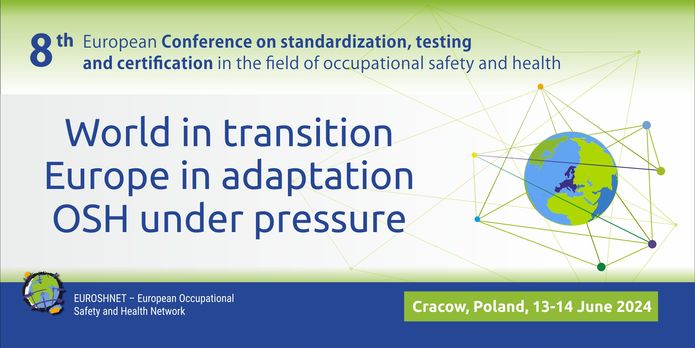Misją Instytutu jest dzialalność naukowo-badawcza prowadząca do nowych rozwiązań technicznych i organizacyjnych użytecznych w kształtowaniu warunków pracy zgodnych z zasadami bezpieczeństwa pracy i ergonomii oraz ustalanie podstaw naukowych do właściwego ukierunkowywania polityki społeczno-ekonomicznej państwa w tym zakresie.
-

General information -

PEROSH -

EUROSHNET -

The Sheffield Group -

ACSH -

International Projects -

EXPOSIM Project -

WAge Project -

HE-FARM Project -

MANiBOT Project -

CONCERT Project -

ASSIST-IoT Project -

Ageing@Work Project -

BACK-UP Project -

InGRID Project -

INCLUSIVE Project -

European Agency for Safety and Health at Work -

European Week for Safety and Health at Work -

CIS/ILO
|
|
European Week for Safety and Health at Work is an information and promotional campaign that has been organised by the European Agency for Safety and Health at Work since 2000. Information campaigns are held on a defined week during the year in all European Union member states on a selected theme for that year. Conferences, workshops and exhibitions are held during these weeks, and posters and information materials are distributed. The theme selected for the year is broadcast in the media and information on the theme is distributed throughout society.
In 2000, the European Week for Safety and Health at Work was devoted to the problems of musculoskeletal disorders; in 2001, the selected theme was the accident prevention at work. In 2002, the theme for the Week was the issue of Working on stress, to which an information campaign was devoted on the prevention of work-related stress. The campaign was supported by all European Union member states, the European Commission and the European Parliament, as well as the trade unions and the confederations of employers. In 2003, the European Week for Safety and Health at Work was devoted to the protection of life and health against the actions of hazardous substances.
European campaign 2008-2009 on Risk Assessment “Healthy Workplaces. Good for you. Good for business”
The overall aim of the campaign 2008-2009 is to promote an integrated management approach that takes into account the different steps of risk assessment.
The two-year risk assessment campaign seeks to convey clearly that risk assessment is a systematic examination of all aspects of the work undertaken to consider what can cause injury or harm, whether the hazards can be eliminated and, if not, what preventive or protective measures are, or should be, in place to control the risks.
The campaign seeks to demystify the risk assessment process; risk assessment is not necessarily complicated, bureaucratic or a task only for experts.
It also promotes the idea of a participatory approach to risk assessment. It is essential for the workforce to be consulted and involved in the risk assessment to ensure that hazards are identified not only from principles of knowledge but also by knowledge of working conditions and patterns of adverse effects upon workers.
Risk assessment with its component of worker involvement is one of the key elements in building a sustainable prevention culture.
The Lighten the load campaign in 2007 seeks to promote an integrated management approach to tackle MSDs embracing prevention of MSDs, and the retention, rehabilitation and reintegration of workers who already suffer from MSDs. This approach includes three elements that are important for its successful implementation:
- Employers, employees and government working together as one body to tackle MSDs
- Addressing the whole load on the body leading to MSDs, and
- Managing the retention, rehabilitation and return to work of those who suffer or have suffered MSDs
A special focus should be placed on multidisciplinary approaches where the prevention side is working with the rehabilitation side. Particularly important is the role of social and organisational support in enabling workers both to return to work and subsequently to sustain employment when experiencing MSDs.
The European Week for Safety and Health at Work in 2004, which focused on construction, was designed to help all stakeholders in the industry realise this potential and build a safer, healthier and more productive working environment. The campaign culminated with the European Week for Safety and Health at Work during 18-22 October 2004. All safety and health institutions and organisations, trade unions, companies, managers, employees and safety representatives were invited to take part and organise their own events during this week. More information:
pl.osha.europa.eu

